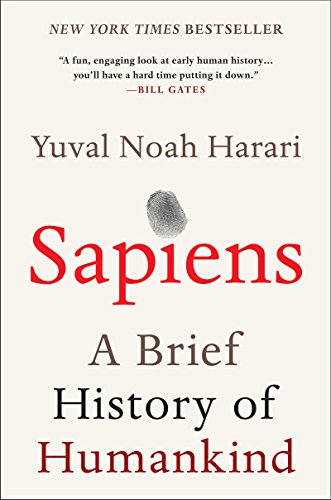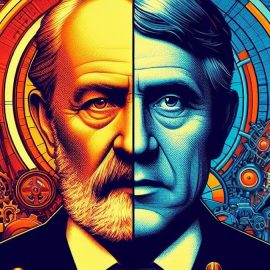

This article is an excerpt from the Shortform summary of "Sapiens: A Brief History of Humankind" by Yuval Noah Harari. Shortform has the world's best summaries of books you should be reading.
Like this article? Sign up for a free trial here .
We’ve only been working in offices and, before that, as farmers and herders, for the last 12,000 years. For hundreds of thousands of years before that, the majority of our species’ history, we lived in hunter-gatherer societies.
Hunter-gatherer societies were the predominant form of societies for early humans. We don’t know much about these societies, but we do know that hunter-gatherers were probably some of the most skilled and informed humans in history.
We’ll cover the nomadic hunter-gatherer lifestyle and evidence of forager belief systems.
We Don’t Know Much About Hunter-Gatherer Societies
Because hunter foragers moved every week, sometimes every day, they had few personal possessions. They only had what they could carry themselves, without the aid of wagons or pack animals. Consequently, Sapiens during the period between the Cognitive Revolution and the Agricultural Revolution left few artifacts. Dependence on the few artifacts discovered creates an incomplete and even misleading picture of our ancestors.
It’s also hard to talk about the hunter-gatherer lifestyle because there was no single way of life (as there isn’t now). Still, attempting to piece together how our ancestors lived from 70,000 to 12,000 years ago can give us insight into our modern society.
Hunter-Gatherer Societies: The Few Things We’re Pretty Sure Of
- There weren’t many humans. The whole human population was smaller than the number of people living in Cairo today.
- Sapiens lived in bands of up to several hundred individuals.
- Neighboring bands cooperated, but also fought. Each band was likely independent. They traded with each other, but weren’t dependent on each other for essentials like fruit and meat. They traded “prestige items” like shells and pigments.
- There were no permanent homes, towns, or governments. Sapiens roamed back and forth across their territory, according to animal migrations and changes in the seasons. Fishing villages might be an exception.
- They ate broadly: termites, berries, roots, rabbits, bison, and mammoth, among other foods.
- They had knowledge: There was little specialization of skills. Everyone needed to know how to make a knife, mend clothing, trap prey, escape lions, and heal snakebites. Sapiens in nomadic hunter-gatherer societies were some of the most skilled and informed people in history.
Hunter-Gatherers Had a Good Life
Hunter-gatherers had many advantages over their descendants. The hunter-gatherer lifestyle was a good one.
Short Working Hours
Westerners spend an average of 40-45 hours working a week (and some people in developing countries work up to 80 hours a week). Even modern foragers, who generally live in inhospitable environments, hunt and gather for 35-45 hours a week.
It’s very possible that humans in nomadic hunter-gatherer societies spent much less time working to find food and resources. Many of them lived in lands much more fertile than the Kalahari Desert. They also didn’t have the chores that take up our time today, like vacuuming, paying bills, and washing dishes.
Health
There were a couple of reasons early hunter-gatherers were taller and healthier than Sapiens after the Agricultural Revolution.
Because early hunter-gatherers might eat berries, snails, and rabbit one day and mushrooms, fruits, and mammoth the next, they were rarely malnourished. They got all the nutrition they needed from the variety in their diets.
Farmers, and the societies that depend on them, tend to rely on calories from a single crop, like wheat or rice. Relying on one food means you’re not getting the variety of nutrients you need to be healthy.
Additionally, the populations of hunter-gatherer societies were spread thinly across the land. Epidemics were uncommon. Later societies would live in close quarters and unhygienic environments, fueling the spread of dangerous epidemics.
Hunter-Gatherer Had Their Own Problems
Although hunter-foragers had many advantages over later Sapiens, we shouldn’t idealize their societies. Hunter-gatherers dealt with issues that have decreased over time.
For instance, child mortality was high. Interactions with wild animals often resulted in death. People who slowed down the group, including the elderly, disabled, and children, may have been killed.
Our ancestors were neither wholly good nor wholly bad. Just like us, they were human, doing their best to survive in sometimes difficult circumstances.
The Things We Can’t Know about the Hunter-Gatherer Lifestyle
There are gaps in our knowledge about hunter-foragers that probably won’t ever be filled.
Was There Religion?
Yes, but we can’t know much about our ancestors’ fictions. We can make guesses about their beliefs, but those guesses often say more about our modern biases than about what nomadic hunter-gatherers thought and felt.
Animism
Most experts agree that early foragers were animists rather than theists.
- Animism: The belief that every animate and inanimate thing has thoughts and feelings and can communicate with people. This belief system is non-hierarchical—all beings are equal.
- Theism: The belief in a god or gods that are above us in status and create the universal order of our world. This belief system is hierarchical—divine beings outrank non-divine beings.
Our hunter-gatherer ancestors probably believed that all animate things (mice, deer, and spirits) and inanimate things (rocks, rivers, and trees) had feelings and desires. They also had the capability to reward or punish Sapiens for their actions.
Because animism is non-hierarchical, there were no walls separating people from the rest of the natural world. People were not of a higher status than other animals, plants, spirits, and inanimate objects. Forager Sapiens didn’t believe that spirits, trees, and animals existed to serve or please them.
Animism doesn’t refer to a particular religion. Within this general concept, there were probably many religions practiced and beliefs believed by early hunter-gatherers.
Evidence of Early Fictions in Hunter-Gatherer Societies
Although we don’t know what early hunter-gatherers believed, we do know that they had fictions.
For example, in Russia, archeologists discovered burial site containing numerous graves. Most of the graves were unnotable, but one contained the skeletons of two children, a boy and a girl. The children were adorned with thousands of ivory beads and fox teeth and were surrounded by statuettes and other ivory objects.
Carving the beads alone would have involved 7,500 hours of work. It was clear that there was something special about these kids. But these kids were too young to have achieved prominence in their band by being great leaders or hunters.
We don’t know why they were special, but it’s clear that this band held some kind of imaginary reality that gave the children status beyond their DNA or their ability to help the band survive and procreate.
—-
Even though we’ll never know what our ancestors believed, what their social structures looked like, or what political strife occurred, it’s crucial that we speculate. If we don’t ask how hunter-gatherer societies shaped our current world, we might assume that they didn’t. But, as we’ll see in the next chapter, Sapiens after the Cognitive Revolution reshaped the natural and social worlds around them, legacies we still grapple with today.
———End of Preview———

Like what you just read? Read the rest of the world's best summary of "Sapiens" at Shortform . Learn the book's critical concepts in 20 minutes or less .
Here's what you'll find in our full Sapiens summary :
- How Sapiens outlived and outlasted the 8+ other human-like species on Earth
- The 3 critical revolutions in human existence that led to our domination of the planet
- How much of what powers our world today is really just a shared mass delusion
- What the future of humanity might look like






